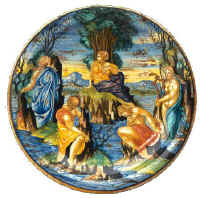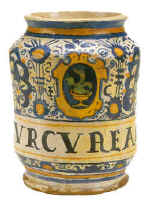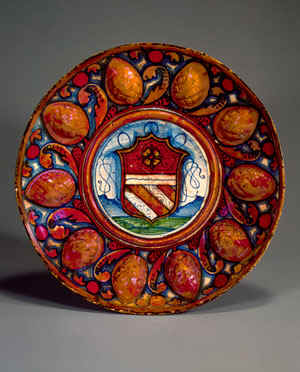|
No one has provided a satisfactory explanation of why ceramic arts have
reached an artistic peak in any given region during a particular period.
Perhaps there is no single reason. English delft was initiated in the 16
C by migrant Dutch potters. It was at its best in the second half of the
17 C, when it was simply decorated and in some cases possessed unrivalled charm, but at that time England was not producing any other art of particular merit. In Turkey, pottery reached its peak in the late
15 C with Iznik ware and in Spain ceramics peaked in the late 14 C and 15
C.
Partly
as a result of a search for the cause of the Black Death in the 14 C and
15 C, many inhabitants of the Italian peninsula at that time came to
think of clay pots as unhygienic, with the result that they destroyed much of the pottery dating from the
13 C to the early 15 C. These ceramics seldom had charm and usually compared unfavourably with the contemporary and earlier
ceramics produced in Islamic countries. Up to about 1420, the decoration consisted mostly of geometric motifs that sometimes incorporated stylised animals. This very early Italian pottery was influenced by imports into Southern Italy from Islamic North Africa that commenced about 1200.
The best Italian majolica was produced between approximately 1440 and
1540. Before 1440, the decoration was too primitive and after 1540 the products of most factories were
showing signs of decadence, the decoration losing its raw mediaeval dynamism and strength. It is particularly the
albarelli that convey the magic of early Renaissance Tuscan
maiolica, especially those made in the second half of the
15 C.

Albarelli
From 1520 onwards, there was a tendency for the decoration to become more detailed and sophisticated and it lost some of its dramatic quality in the process. After about 1500 designs were often taken from engravings. The visual rhythm became gentler.

In the late 15 C, Italian majolica was influenced by Moorish Spain, which traded with Italy through Florence, and
later by Greek and Roman art. Most of the very early claywares were produced in Tuscany and Umbria at factories in
Orvieto, Perugia
and Florence. Primarily, Italian pottery produced before 1350 had a lead glaze. In the
13 C, 14 C and earlier part of the 15 C, the only colours used were green and manganese/purple, derived respectively from oxides of copper and manganese, and subsequently a dark cobalt blue.
However, by the end of the
15 C, the colour range was widened and consisted of blue from cobalt, green from copper, yellow from antimony, orange from antimony and iron, and purple and brown from manganese. At an early date
red was a difficult colour to achieve and often turned out to be more of a sealing wax colour than a true red.

Albarello
- Montelupo
|

Flask
- Urbino |
Italian majolica wares were first produced about 1350. They had a glaze that was composed of a lead oxide opacified with tin oxide combined with a silicate of potash. The decoration was applied to the dried glaze which was porous and demanded accurate painting,
since errors could not be later
rectified. Consequently there is a spontaneity and rhythm to the painting which is peculiar to this medium. Once fired, the colours were permanently fixed and are seen now as there were seen hundreds of years ago.
Many of the finer early pieces of antique Italian majolica had a second coating of a lead glaze, known as
coperta, before the second firing. This improved the quality of the colours and appearance of the surface. The coperta glaze was composed of lead oxide combined with sand, potash and salt.
Sgraffiato wares, inspired by Near Eastern examples, were introduced in the
16 C. These used a lead glaze. The unfired dark biscuit body of a piece was dipped in a white slip of pipe clay mixed with water. It then received its first firing. Designs were then engraved with a pointed tool made of wood or iron. Once the engraving was complete, a lead glaze was applied and a second firing took place. In some cases further decoration was painted on using underglaze pigments before the final firing. This decoration was sometimes applied to areas where the slip had been cut away to reveal the dark body beneath.

Sgraffiato - north Italy 15-16 C
Gubbio is most famous for its majolica lustre wares which no doubt were created
as a result of the Hispano-Moresque imported from Valencia in the 15 C. Silver and copper were responsible for the lustre on early pottery and in the case of Gubbio a magical ruby lustre was obtained by the use of copper oxide in the last firing.
Brushwood was burnt towards the end of this firing.

Cup
- Gubbio
Historically there have been major Italian pottery factories in
Impruneta,
Gubbio, Urbino,
Deruta,
Venice, Castel Durante, Sienna and
Caltigerone.
|